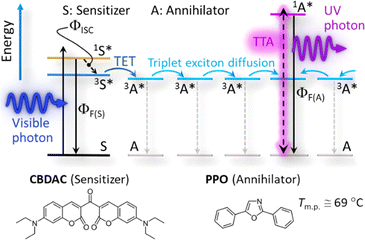Phys.org January 30, 2023
Only about 4% of terrestrial sunlight falls within the UV range in the electromagnetic spectrum. This leaves a large portion of sunlight spectrum unexploited for photopolymerization to form a resin and activation of photocatalysts to drive reactions that generate green hydrogen or useful hydrocarbons (fuels, sugars, olefins, etc.). Photon upconversion (UC) could be the key to solving this problem. Researchers in Japan have developed a revolutionary solid film that can perform visible-to-UV photon UC for weak incident light while remaining photostable for an unprecedented amount of time in air. The film is completely solvent-free “green” formation of bicomponent organic polycrystalline films for efficient visible-to-ultraviolet photon upconversion (UV–UC). The conversion was achieved by temperature-gradient solidification from the melt. The UV–UC film formed under optimal conditions exhibited an ultralow excitation threshold (0.3 suns, AM1.5 spectrum with a 413 nm long-pass filter) and a record-long photostability (>100 h) in air. For demonstration they used it with a 1-sun-intensity simulated sunlight consisting only of visible light to successfully cure and solidify a resin that would otherwise require UV light for the same process. According to the researchers their invention of UC solids with unprecedented photostability can be realistically used for the upconversion of low-intensity visible light photons into UV light photons in the presence of air…read more. Open Access TECHNICAL ARTICLE

Schematic energy diagram of TTA-UC in this study. X, 1X*, and 3X* …Credit: J. Mater. Chem. C, 2023, Advance Article